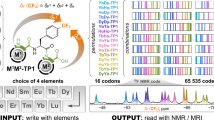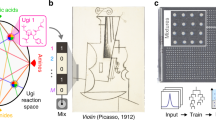Abstract
Since the introduction of molecular computation1,2, experimental molecular computational elements have grown3,4,5 to encompass small-scale integration6, arithmetic7 and games8, among others. However, the need for a practical application has been pressing. Here we present molecular computational identification (MCID), a demonstration that molecular logic and computation can be applied to a widely relevant issue. Examples of populations that need encoding in the microscopic world are cells in diagnostics or beads in combinatorial chemistry (tags). Taking advantage of the small size9 (about 1 nm) and large ‘on/off’ output ratios of molecular logic gates and using the great variety of logic types, input chemical combinations, switching thresholds and even gate arrays in addition to colours, we produce unique identifiers for members of populations of small polymer beads (about 100 μm) used for synthesis of combinatorial libraries10,11. Many millions of distinguishable tags become available. This method should be extensible to far smaller objects, with the only requirement being a ‘wash and watch’ protocol12. Our focus on converting molecular science into technology concerning analog sensors13,14, turns to digital logic devices in the present work.
This is a preview of subscription content, access via your institution
Access options
Subscribe to this journal
Receive 12 print issues and online access
$259.00 per year
only $21.58 per issue
Buy this article
- Purchase on Springer Link
- Instant access to full article PDF
Prices may be subject to local taxes which are calculated during checkout


Similar content being viewed by others
References
de Silva, A. P., Gunaratne, H. Q. N. & McCoy, C. P. A molecular photoionic AND gate based on fluorescent signalling. Nature 364, 42–44 (1993).
Adleman, L. M. Molecular computation of solutions to combinatorial problems. Science 266, 1021–1024 (1994).
Raymo, F. M. Digital processing and communication with molecular switches. Adv. Mater. 14, 401–414 (2002).
Balzani, V., Venturi, M. & Credi, A. Molecular Devices and Machines: A Journey into the Nanoworld (Wiley-VCH, Weinheim, 2003).
de Silva, A. P. & McClenaghan, N. D. Molecular-scale logic gates. Chem. Eur. J. 10, 574–586 (2004).
Szacilowski, K. Molecular logic gates based on pentacyanoferrate complexes: From simple gates to three-dimensional logic systems. Chem. Eur. J. 10, 2520–2528 (2004).
Margulies, D., Melman, G. & Shanzer, A. A molecular full-adder and full-subtractor, an additional step toward a moleculator. J. Am. Chem. Soc. 128, 4865–4871 (2006).
Stojanovic, M. N. & Stefanovic, D. A deoxyribozyme-based molecular automaton. Nature Biotechnol. 21, 1069–1074 (2003).
Uchiyama, S., McClean, G. D., Iwai, K. & de Silva, A. P. Membrane media create small nanospaces for molecular computation. J. Am. Chem. Soc. 127, 8920–8921 (2005).
Lam, K. S. et al. A new type of synthetic peptide library for identifying ligand-binding activity. Nature 354, 82–84 (1991).
Furka, A., Sebestyen, F., Asgedom, M. & Dibo, G. General-method for rapid synthesis of multicomponent peptide mixtures. Int. J. Pept. Prot. Res. 37, 487–493 (1991).
Queen’s University of Belfast. Labelled solid support comprising fluorophore label. British patent 0506480.3 (2005).
de Silva, A. P. et al. Signaling recognition events with fluorescent sensors and switches. Chem. Rev. 97, 1515–1566 (1997).
Brummel, C. L., Lee, I. N. W., Zhou, Y., Benkovic, S. J. & Winograd, N. A. mass spectrometric solution to the address problem of combinatorial libraries. Science 264, 399–402 (1994).
Ohlmeyer, M. H. J. et al. Complex synthetic chemical libraries indexed with molecular tags. Proc. Natl Acad. Sci. USA 90, 10922–10926 (1993).
Bioarray Solutions & Rutgers, The State University of New Jersey. Colour-encoding and in-situ interrogation of matrix-coupled chemical compounds. World patent WO 98/53093 (1998).
Smith Kline Beecham Corp., Method of encoding a series of combinatorial libraries and developing structure-activity relationships. US patent 6,210,900 B1 (2001).
Egner, B. J. et al. Tagging in combinatorial chemistry: The use of coloured and fluorescent beads. Chem. Commun. 735–736 (1997).
Scott, R. H. & Balasubramaniam, S. Properties of fluorophores on solid phase resins; implications for screening, encoding and reaction monitoring. Bioorg. Med. Chem. Lett. 7, 1567–1572 (1997).
Walt, D. L. Bead-based fiber-optic arrays. Science 287, 451–452 (2000).
Battersby, B. J., Lawrie, G. A., Johnston, A. P. R. & Trau, M. Optical barcoding of colloidal suspensions: applications in genomics, proteomics and drug discovery. Chem. Commun. 1435–1441 (2002).
Dickinson, T. A., Michael, K. L., Kauer, J. S. & Walt, D. R. Convergent, self-encoded bead sensor arrays in the design of an artificial nose. Anal. Chem. 71, 2192–2198 (1999).
Lavigne, J. J. et al. Solution-based analysis of multiple analytes by a sensor array: Toward the development of an “electronic tongue”. J. Am. Chem. Soc. 120, 6429–6430 (1998).
Nicolaou, K. C., Xiao, X. Y., Parandoosh, Z., Senyei, A. & Nova, M. Radiofrequency encoded combinatorial chemistry. Angew. Chem. Int. Edn 34, 2289–2291 (1995).
Moran, E. J. et al. Radiofrequency tag encoded combinatorial library method for discovery of tripeptide-substituted cinnamic acid of the protein tyrosine phosphatase. J. Am. Chem. Soc. 117, 10787–10788 (1995).
Millman, J. & Grabel, A. Microelectronics (McGraw-Hill, London, 1988).
Collier, C. P. et al. Electronically configurable molecular-based logic gates. Science 285, 391–394 (1999).
Copeland, G. T. & Miller, S. J. A chemosensor-based approach to catalyst discovery in solution and on solid support. J. Am. Chem. Soc. 121, 4306–4307 (1999).
Hayes, B. Am. Scientist 89, 490–494 (2001).
Jin, N. et al. Tri-state logic using vertically integrated Si-SiGe resonant interband tunneling diodes with double NDR. Electron Devices Lett. 25, 646–648 (2004).
Keyes, R. W. Physics of digital devices. Rev. Mod. Phys. 61, 279–287 (1989).
Acknowledgements
We thank DEL, EPSRC, Avecia Ltd, Invest NI (RTD COE 40), A. Lavery (Avecia Ltd), D. Corry (HMG Powder Coatings Ltd), M. Schroeder (Technical University, Graz), C. McCoy and D. Coulson (School of Pharmacy, QUB) for their support and help.
Author information
Authors and Affiliations
Corresponding author
Ethics declarations
Competing interests
The authors declare no competing financial interests.
Supplementary information
Supplementary information
Supplementary information
Rights and permissions
About this article
Cite this article
Prasanna de Silva, A., James, M., McKinney, B. et al. Molecular computational elements encode large populations of small objects. Nature Mater 5, 787–789 (2006). https://doi.org/10.1038/nmat1733
Received:
Accepted:
Published:
Issue Date:
DOI: https://doi.org/10.1038/nmat1733
This article is cited by
-
A ratiometric fluorescent nanoprobe consisting of ssDNA-templated silver nanoclusters for detection of histidine/cysteine, and the construction of combinatorial logic circuits
Microchimica Acta (2019)
-
Multicomponent reactions provide key molecules for secret communication
Nature Communications (2018)
-
Message in a molecule
Nature Communications (2016)
-
Orthogonal photoswitching in a multifunctional molecular system
Nature Communications (2016)
-
DNA-based advanced logic circuits for nonarithmetic information processing
NPG Asia Materials (2015)



